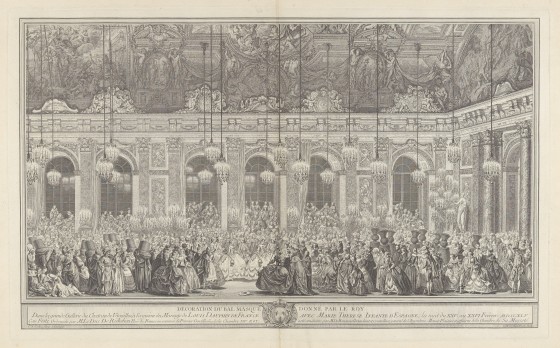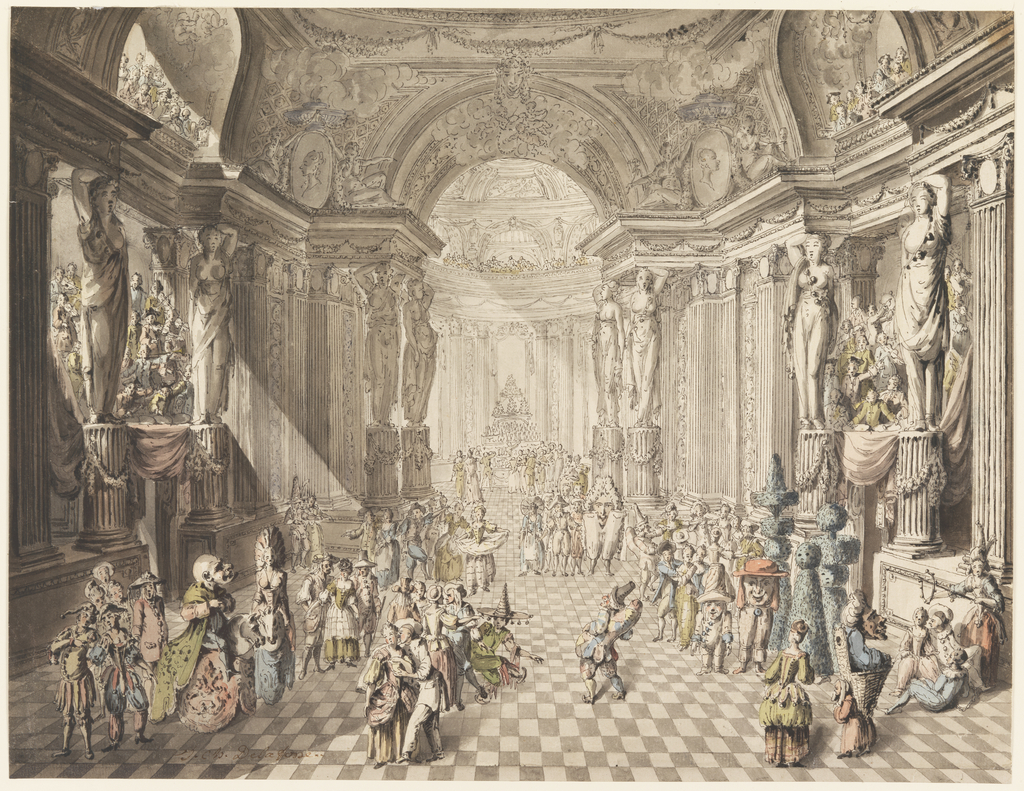Dancers in outrageous costumes and masks mingle in a lavish interior. This finished drawing likely depicts a Parisian vauxhall, which were public entertainment spaces, often set in, or near, pleasure gardens. They were first popularized in seventeenth-century England, and became fashionable in France in the late 1760s with the construction of the Colisée (The French word for the Colosseum, it was designed by Louis-Denis Le Camus from 1769-71). The latter was a modern center of mass sociability and played host to art exhibitions, concerts, balls, and other public spectacles until the late 1770s.
Light pours in through unseen windows, and spotlights a colorful cast of characters: the hunchback Punchinello and Pierrot, iconic characters of commedia dell’arte dance amongst the crowd while revelers twirl in a circle or are paired in a contredanse. On one side, a group of people dressed as yew trees survey the scene. Musicians play on elevated balconies on both side of the hall while onlookers gaze down from the uppermost balconies. The yew trees are likely a reference to the Yew Tree Ball held at Versailles on 25 February 1745, where Louis XV came disguised as a yew tree and famously encountered Madame de Pompadour, who would become his mistress and one of the most influential art patrons of the eighteenth century. Delafosse may have modeled the costumes after designs by Louis-René Boquet or other costume designers working for the Menus plaisirs du roi or for the Académie royale de musique. For example, the oversized characters are similar to costumes in the Yew Tree Ball or to an anonymous drawing in the Lodewijk Houthakker Collection depicting a costume for a masquerade ball.[1]

Print, Decoration for a Masked Ball at Versailles, on the Occasion of the Marriage of Louis, Dauphin of France, and Maria Theresa, Infanta of Spain, ca. 1860, reprint of 1764; Designed by Charles Nicolas Cochin I (French, 1688–1754 ), after Charles Nicolas Cochin II (French, 1715–1790); Etching with engraving; 47.6 x 76.8 cm; The Metropolitan Museum of Art, New York; Harris Brisbane Dick Fund, 1930, Inv. No. 30.22(34.34)
The grandiose interior is in fact a capriccio, an imaginary or fantastical space overflowing with Jean-Charles Delafosse’s exuberant decorations in the Greek style, an early form of neoclassicism that emerged in the 1760s. Delafosse, the Parisian architect, designer, decorator and printmaker who belonged to the Académie de Saint-Luc—the artisans’ guild— was often criticized for his weighty designs. In this space, Delafosse again defies all rules of architectural propriety, as established by the Academy, as he has created an overly ornamented hall supported by oversized caryatids. On either side of the main archway are sculpture groups with smoking urns with the smoke appearing to fill to the room—further presenting the interior as a capriccio. The garlands wrapped around the columns are likely a reference to the actual interior of the Colisée as featured in a drawing by Gabriel de Saint-Aubin, which shows another fête at the vauxhall. The interior can also be compared to Delafosse’s cross-section drawing of a modern Colisée (Victoria and Albert Museum, London, Inv. No. E.918-1949), which displays an equally opulent interior filled with massive statuaries, ornaments à la grec, and a network of balconies.
The particular drawing was likely a pendant to a drawing by Delafosse at the Canadian Centre for Architecture (CCA) titled Masquerade (Inv. No. Cca. Dr. 1984:1462). The Canadian sheet also depicts a ball in a great hall and the yew trees and the bald character riding a horse in the lower right corner of the Cooper Hewitt sheet is featured again in the Canadian version. These drawings are highly finished and were likely owned by a collector interested in the licentious spectacles at Parisian vauxhalls.
[1] See cat 672 in Peter Fuhring, Design into Art: Drawings for Architecture and Ornament—the Lodewijk Houthakker Collection, Vol II (London : P. Wilson Publishers, 1989), p. 419.
Cabelle Ahn is a graduate intern in the Department of Drawings, Prints and Graphic Design at the Cooper Hewitt, Smithsonian Design Museum. She received her MA in Art History from the Courtauld Institute of Art and is currently studying eighteenth century decorative arts at the Bard Graduate Center.
